Table of Contents [hide]
Fuel oil tanks are essential for oil heating systems, providing a secure method to store fuel. However, this system has its challenges. Water can infiltrate these tanks, leading to oil tank condensation—a typical issue that can be effectively managed. Continue reading this article from Lake Region Energy to gather critical information about this issue.
Understanding Oil Tank Condensation & Prevention Methods
Discover key insights into oil tank condensation and how to prevent it effectively.
The Entry of Water into Home Oil Tanks
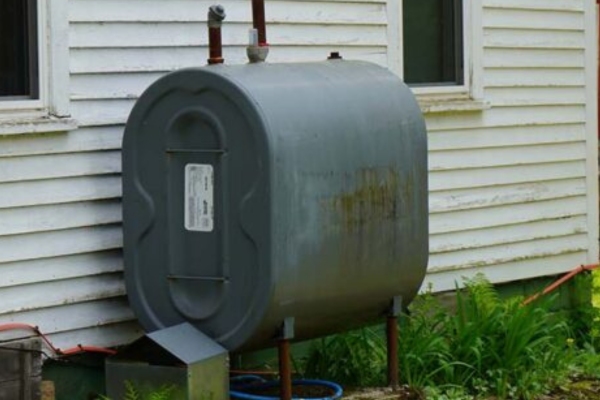
Water is a ubiquitous environmental element and can enter oil tanks in various forms, often gradually accumulating over time. Identifying how water penetrates your oil tank is crucial in developing strategies to prevent future incidents.
Enhance your home’s energy efficiency and comfort with our home comfort services. Contact Lake Region Energy now.
Rainwater Exposure
Outdoor oil tanks are particularly vulnerable to rainwater, which can infiltrate through even the smallest openings, such as loosely fitted caps or gaps in lids. Additionally, tanks positioned near a house may be affected by overflowing gutters. Over time, older tanks can develop weak points like deteriorating seals or cracked walls, increasing the risk of water entry.
Oil Tank Condensation Risks

Condensation poses a consistent threat to oil tanks, regardless of their location. External moist air can be drawn into the tank through air vents. When the inside temperature of the tank is sufficiently low, this moisture can condense from vapor to liquid, forming droplets on the interior walls that eventually settle at the bottom. Initially, a few droplets may seem fine, but condensation can progressively improve with proper measures.
Groundwater Challenges
Underground oil tanks face unique challenges. If there are openings around the container, groundwater can compromise them. This issue is particularly concerning because water can enter, and oil can leak out, leading to soil contamination. Address any signs of damage to underground tanks immediately by seeking professional assistance.
Implications of Water in Your Heating Oil Tank
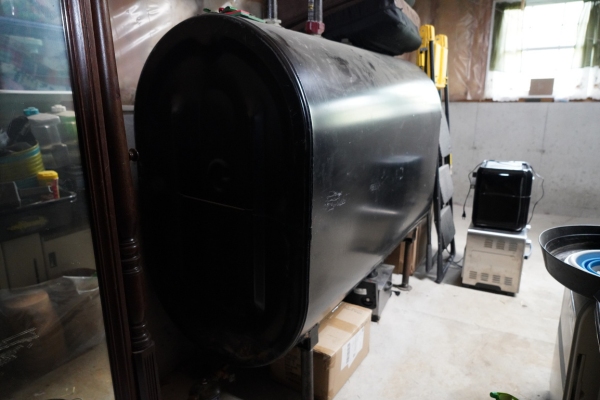
Detecting water in a heating oil tank is challenging because oil floats on water, making visual identification difficult. This issue is especially pronounced with underground tanks, where accessibility is limited. Often, water in the tank remains undetected for extended periods, only becoming noticeable when problems start to manifest.
Taking proactive measures to prevent water ingress in your oil tank is far more advantageous than addressing the aftermath of water damage. Regular maintenance and routine inspections are essential to avoid complications. For these inspections, use a water-finding paste following your manufacturer’s guidelines.
You can also consult with a heating oil expert to detect moisture. Apply the paste at the tank’s bottom, where water typically accumulates; a change in the paste’s color signals the presence of moisture. If a significant amount of water is detected, involving a professional immediately is crucial.
Protect your heating system from water damage. Book an appointment with our HVAC specialists today. Call Lake Region Energy today!
Strategies to Prevent Heating Oil Tank Condensation
Now that you understand the potential issues, it’s essential to focus on preventing further water entry into your oil tank. Here are several straightforward strategies to help you safeguard your system:
Inspecting the Fuel Oil Tank
Regularly inspect the exterior of your fuel oil tank for signs of wear and tear, such as rust, chipped paint, and any perforations. Ensure all lids and caps are securely closed; tighten them if necessary. This routine check helps prevent environmental elements from compromising the tank’s integrity.
Testing for Water in Your Tank
Since visual inspections might not reveal all issues, it’s essential to test for water presence within your tank periodically. Apply a water-finding paste, adhering to your manufacturer’s recommendations or after consulting a heating oil expert, to probe the bottom of the cylinder where water will likely accumulate. For underground tanks, consider conducting soil contamination tests to detect leaks.
Shielding Your Home Heating Oil Tank from Heat
Position new tanks in shaded areas and coat the exterior with reflective, light-colored paint to minimize condensation caused by temperature fluctuations. This strategy protects the tank from absorbing excessive heat and significantly reduces the risk of condensation building up inside.
Maintaining a Full Fuel Oil Tank
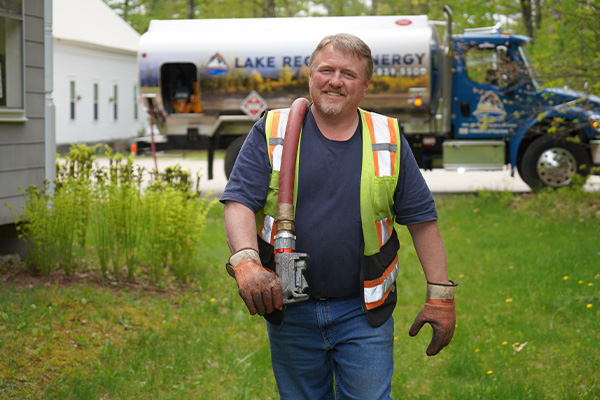
To prevent condensation, keep your home oil tank as complete as possible. Lower fuel levels allow more moist air to enter, which increases the likelihood of condensation forming. Schedule oil deliveries before levels drop too low and maintain a full tank during the heating and off-season seasons.
Call Lake Region Energy for prompt, reliable, and friendly fuel delivery, oil tank services, and HVAC solutions you can trust. Call now!
Consulting Professionals
Professionals can thoroughly inspect and, if necessary, replace your heating oil tank. They also provide expert advice on optimal tank placement to maximize its lifespan.
Professional Water Removal from Your Oil Tank
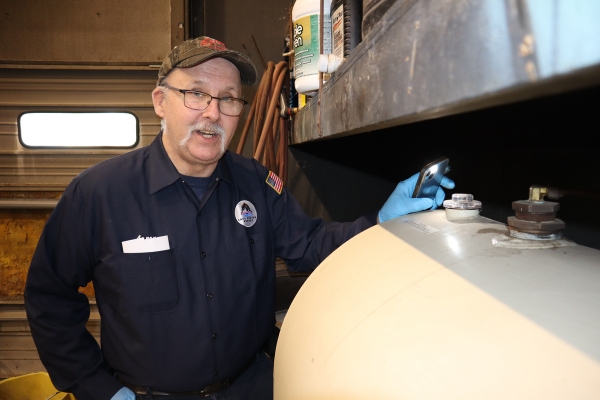
If water is detected in your oil tank through moisture testing, it’s crucial to have it removed by a professional. Here are some steps a professional might take, depending on the situation:
- Drain: Many metal tanks are equipped with a sludge valve at the bottom. A professional can open this valve to allow the water to drain out. It’s common for some oil to escape during this process, which they will collect and dispose of properly to ensure environmental safety.
- Pump: A hand pump may remove small amounts of water from plastic tanks, which typically lack a sludge valve. If the water volume is substantial, professional intervention is necessary.
- Absorb: Professionals might use water-absorbent socks placed inside the tank to manage moisture. These socks prevent water from settling at the bottom but must be replaced every few months. Proper disposal of the used socks is crucial. Additionally, an alcohol-based dispersant can be used as an alternative method.
The Risks of Ignoring Water in Your Oil Tank
Here are several potential damages of not removing water from your oil tank:
Oil Tank Rust
While water may seem harmless, neglecting its presence in your oil tank can lead to significant damage over time. Water can cause corrosion of the tank walls, particularly in steel tanks, which typically rust from the inside out. The tank might look intact from the outside but could be deteriorating internally. This corrosion weakens the tank walls and can lead to future problems, reducing the system’s efficiency and performance.
Freezing Risks in Oil Tanks
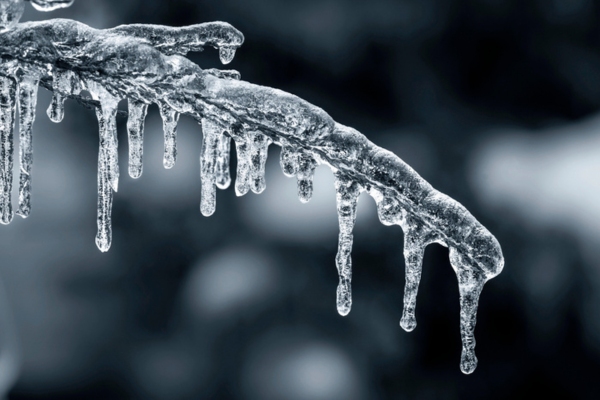
Oil’s resilience to freezing makes it a reliable fuel during winter, but water in the tank does not share this quality. Water freezes at 0 degrees Celsius (32 degrees Fahrenheit), a common winter temperature in many regions. Frozen water within the tank can obstruct oil supply pipes, potentially causing a total system failure precisely when heating is most needed.
Bacterial Growth in Oil Tanks
Water accumulation in oil tanks creates a moist environment conducive to bacterial growth. These bacteria can proliferate and form sludge at the bottom of the tank. Additionally, they may produce acids that accelerate corrosion, damaging the tank and affecting burners, filters, and fuel lines. This can lead to significant maintenance issues.
Conclusion
Water has no place in an oil tank, as it can lead to tank damage and disrupt your heating system. To protect your equipment, adhere to the prevention strategies outlined and seek professional assistance for more complex issues.
Call Lake Region Energy for Top-Notch Heating Oil Delivery Services
For dependable fuel oil delivery in southwestern Maine, trust Lake Region Energy. We ensure prompt, cost-effective service delivered with a friendly approach.
At Lake Region Energy, we are committed to providing excellent service. Contact us to explore our flexible delivery plans and financing options that fit your needs. Additionally, we offer a full suite of HVAC services designed to enhance your home’s energy efficiency, air quality, and comfort. Our team is ready to assist you with routine maintenance to, repairs, and installations. Call us today for unparalleled service and support!
For more information about our fuel deliveries and HVAC services, be sure to contact Lake Region Energy. You can click here to contact us, or you can call us at (207) 839-5500 to find out more. We offer a full line of heating and cooling repairs, maintenance services, and installations. Click the link to view our service area.

Related Articles:
